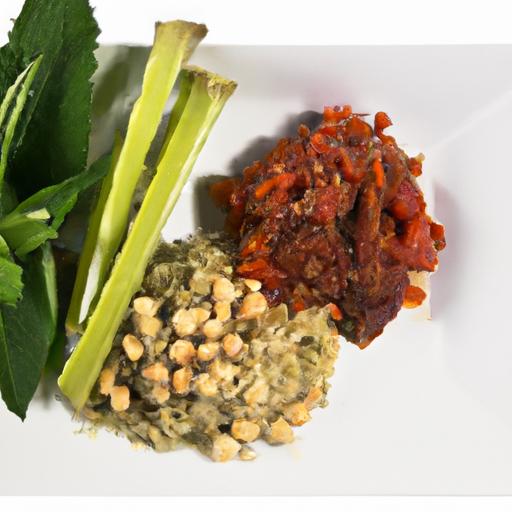There’s a magical alchemy at work when humble ingredients transform through the ancient art of fermentation-unlocking a world of bold, tangy, and umami-packed flavors that can elevate every meal from ordinary to extraordinary. Fermented foods don’t just add depth; they bring a vibrant complexity that dances on your taste buds, turning simple dishes into culinary masterpieces. In this article, we’ll dive into the enchanting science and rich traditions behind fermentation, revealing why these time-honored techniques are our top secret to boosting every dish with unforgettable flavor and nourishing goodness. Get ready to awaken your palate and discover the powerful punch of fermented flavors!
Fermented Flavors: Unlocking the Umami in Every Bite
Fermented flavors unlock a culinary world where simple ingredients transform into vibrant, umami-rich powerhouses. This ancient art of fermentation is not just a preservation method but a flavor enhancer that deepens complexity and invites new taste adventures in everyday cooking. Inspired by time-honored traditions and fresh creativity, this recipe invites you to master a basic yet transformative fermented condiment-homemade kimchi-that will elevate any meal from ordinary to extraordinary.
Prep and Cook Time
- Prep Time: 20 minutes
- Fermentation: 3-7 days (depending on your taste preference and room temperature)
Yield
- Approximately 1 quart (4 servings)
Difficulty Level
- Medium-requires patience and attention to detail, but no specialized equipment
Ingredients
- 1 medium Napa cabbage (about 2 pounds), chopped into bite-sized pieces
- ¼ cup kosher salt for salting the cabbage
- 4 cups water (filtered for best fermentation results)
- 1 tablespoon grated fresh ginger
- 4 cloves garlic, minced
- 2 teaspoons sugar
- 3 tablespoons Korean red pepper flakes (gochugaru) for mild heat and vibrant color
- 5 green onions, sliced thinly
- 1 small carrot, julienned
- 2 tablespoons fish sauce (optional for deep savory notes)
Instructions
- Salt the cabbage: In a large bowl, toss the chopped Napa cabbage with kosher salt and massaging it gently to release moisture. Add water until the cabbage is submerged. Let it sit at room temperature for 2 hours, tossing every 30 minutes to ensure even salting.
- Prepare the spice paste: While the cabbage salts, blend together grated ginger, minced garlic, sugar, gochugaru, and fish sauce in a separate bowl. This paste will build the signature umami and heat.
- Drain and rinse: After 2 hours, drain the cabbage and rinse thoroughly under cold water to remove excess salt. Squeeze gently to expel lingering water. This step is crucial to avoid overly salty kimchi.
- Combine with vegetables: Mix the cabbage with sliced green onions and julienned carrot in a large bowl. Add the spice paste in batches, massaging it into the vegetables to coat evenly.
- Pack and ferment: Transfer the mixture into a clean, airtight glass jar or fermenting crock. Press down firmly to remove air pockets and expose the brine. Leave 1-2 inches of headspace. Seal the jar securely.
- Fermentation time: Store in a cool, dark place around 65-72°F. Check daily, pressing down the vegetables if they float above the brine. Taste after 3 days for tangy, mild flavor; ferment longer for more pungent depth.
- Refrigerate and enjoy: Once the kimchi reaches your preferred tanginess, move it to the fridge to slow fermentation. It will continue flavor development and can last up to 1 month refrigerated.
Chef’s Tips for Success
- Use high-quality fresh Napa cabbage as it balances the crunch and absorbs the spice beautifully.
- Adjust fermentation time based on your local climate-warmer environments accelerate fermentation.
- Experiment by adding different vegetables such as radish, daikon, or even apple slices for a sweet twist.
- Wear gloves when mixing the spice paste to protect your skin from the chili heat.
- If you prefer a vegan version, substitute the fish sauce with tamari or miso paste to maintain umami depth.
Serving Suggestions
This fermented flavor bomb pairs brilliantly with everything from steamed rice bowls to grilled meats. Try it as a vibrant topping on tacos, mixed casually into creamy avocado toast, or as a refreshing side to balance rich stews. Garnish with fresh cilantro, toasted sesame seeds, or a drizzle of toasted sesame oil to amplify the sensory experience-each bite harmonizes spice, crunch, and umami depth.
| Nutrient | Per Serving (¼ cup) |
|---|---|
| Calories | 25 |
| Protein | 1g |
| Carbohydrates | 5g |
| Fat | 0g |

Unlock the vast potential of fermented flavors in your culinary repertoire by mastering this timeless technique. For more inspiration on fermented ingredients and seasonal recipes, check out our complete guide to fermented foods. For a deeper understanding of the complex science behind fermentation, visit the NPR’s coverage on fermentation.
Q&A
Q&A: Fermented Flavors – Our Top Way to Boost Every Dish
Q1: What exactly are fermented flavors?
A1: Fermented flavors are the rich, tangy, and often umami-packed tastes that develop when foods undergo fermentation-a natural process where microbes like bacteria and yeast transform ingredients over time. Think kimchi’s spicy zest, miso’s savory depth, or the subtle funk in aged cheeses. These flavors aren’t just tasty-they’re complex and uniquely satisfying.
Q2: Why should I add fermented flavors to my cooking?
A2: Fermented flavors act like culinary magic wands-elevating dishes by adding layers of interest and depth. They boost umami, the “fifth taste,” making everything from soups to sauces more vibrant. Plus, fermented foods often carry probiotics, adding a potential health kick alongside flavor.
Q3: What are some easy fermented ingredients to keep in my kitchen?
A3: Start simple! Staple pantry heroes include soy sauce, miso paste, sauerkraut, kimchi, and pickled vegetables. Each brings a unique twist-soy sauce enhances savory notes, miso adds creamy richness, and kimchi brings a lively, spicy punch.
Q4: How do I incorporate fermented flavors without overpowering my dish?
A4: A little goes a long way. Begin with small amounts, tasting as you go. For example, stir a spoonful of miso into soups at the end of cooking to preserve its nuanced flavor, or use a splash of fish sauce to subtly enhance marinades. Balance is key-fermented flavors are meant to complement, not dominate.
Q5: Can fermentation boost the nutritional value of my food?
A5: Absolutely! Fermentation can improve digestibility and enrich foods with probiotics, which promote gut health. Beyond nutrition, fermentation can also reduce anti-nutrients in certain foods, making vitamins and minerals more bioavailable.
Q6: Are fermented flavors suitable for all cuisines?
A6: Yes! Fermentation is a global practice, so its flavors fit well in almost any cuisine. From tangy chutneys in Indian dishes to funky cheeses in European recipes, and spicy kimchi in Korean fare, fermented flavors can be adapted creatively to suit your culinary adventures.
Q7: How can I start fermenting at home?
A7: Getting started is easier than you might think! Begin with simple ferments like sauerkraut or pickles. All you need are fresh vegetables, salt, and a clean jar. Let nature do its work over a few days to weeks, and soon you’ll be savoring your own fermented masterpieces.
Embrace the tangy, savory world of fermented flavors and watch your dishes transform from ordinary to extraordinary-one delicious bite at a time!
The Way Forward
In the ever-evolving world of flavors, fermentation stands out as a timeless art that breathes new life into every bite. From tangy kimchi to rich miso, these age-old techniques unlock depths of taste that transform simple ingredients into extraordinary experiences. By embracing fermented flavors, you’re not only enhancing your dishes but also connecting with a tradition that celebrates patience, complexity, and creativity. So next time you cook, think beyond the usual seasonings-let fermentation be your secret ingredient, turning every meal into a vibrant celebration of flavor. Your palate will thank you, and your kitchen will never be the same again.








